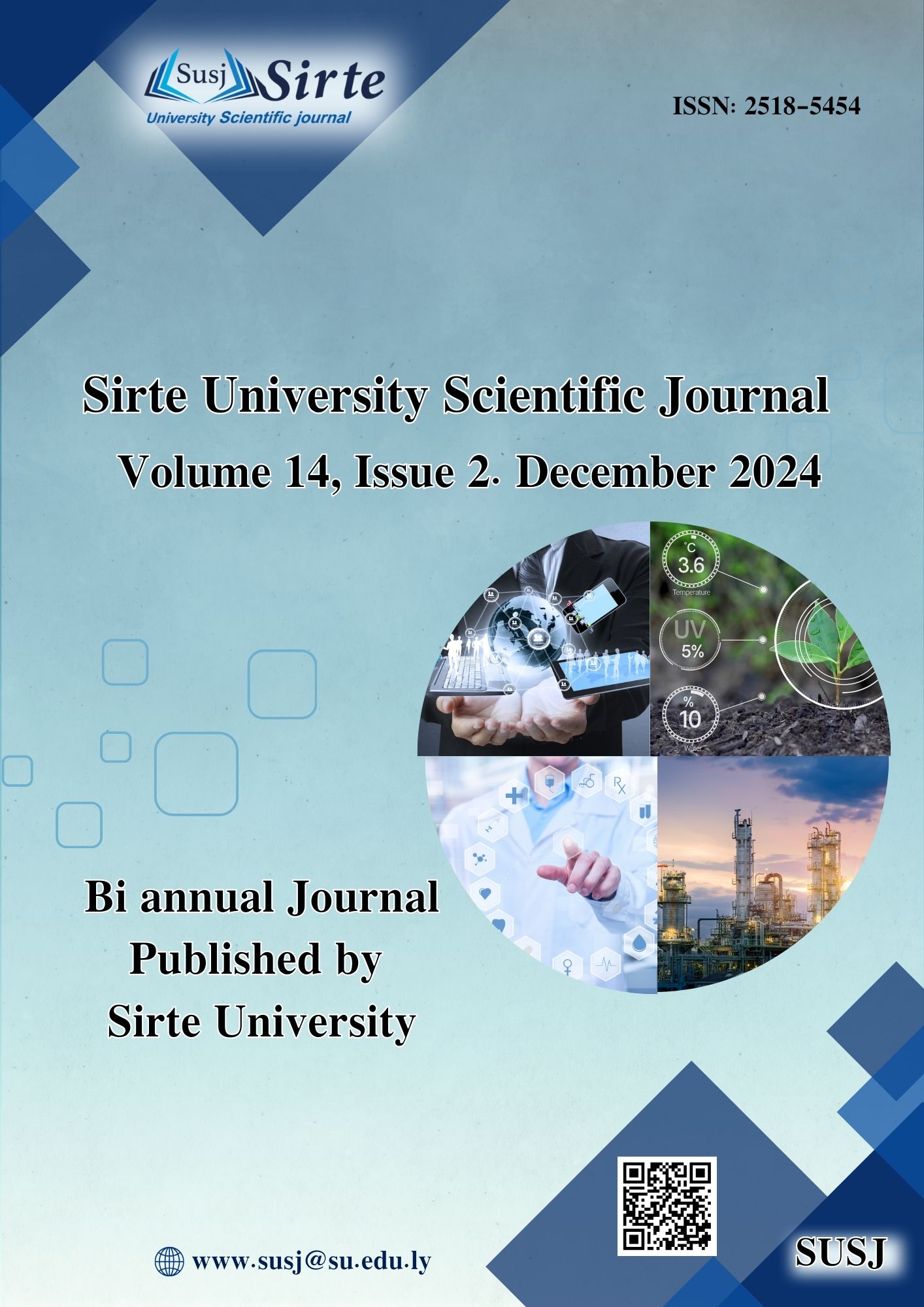Spatial Analysis of Soil Chemical Properties (pH, EC, and CaCO₃%) Using the IDW Method at the Field Scale in Libyan Soil
DOI:
https://doi.org/10.37375/susj.v14i2.3089الكلمات المفتاحية:
Soil salinity (EC)، Soil pH، Soil calcium carbonate content (CaCO₃ %)، Spatial or geographical statistics (Geostatistics)، Mapping soil properties، GIS، IDW، Interpolation.الملخص
Soil chemical properties such as pH, electrical conductivity (EC), and calcium carbonate content (CaCO₃%) are important indicators of soil health and fertility, impacting nutrient availability and crop productivity. Accurate mapping of these properties is especially important in arid and semiarid regions, such as Libya, where soil salinity and alkalinity present challenges to agricultural practices. This study assesses the effectiveness of the Inverse Distance Weighting (IDW) method which is a type of spatial interpolation that estimates values at unsampled locations by weighting nearby sampled points based on their distance from the point being estimated. In IDW, closer points have a greater influence on the estimated value, while more distant points contribute less. IDW method is used for interpolating spatial distributions of soil pH, EC, and CaCO₃% in a 13,000 square meter area at the Faculty of Agriculture Farm, University of Tripoli, Libya. Using a total of 71 soil samples collected from a depth of 0–30 cm, the spatial variability of these properties through IDW was assessed, a method that estimates values at unsampled locations based on the weighted influence of nearby sampled points. The accuracy of IDW interpolations was evaluated through cross-validation, revealing that IDW provided reliable results for CaCO₃%, with R² values ranging from 63% to 75%. In contrast, the method demonstrated moderate effectiveness for pH (R² values between 41% and 50%) and lower accuracy for EC, with R² values as low as 6%. This suggests that soil pH and EC exhibit varying levels of spatial homogeneity, affecting the interpolation accuracy. Alternative methods like Kriging may be more appropriate for EC due to their capacity to account for spatial autocorrelation, a key factor in environmental variables such as soil properties. The findings underscore the importance of selecting appropriate interpolation techniques based on the specific characteristics of soil properties and their spatial distribution.
المراجع
Aboukarima, A. M., Taha, M., & Hassan, H. (2018). Geostatistical analysis and spatial mapping of soil salinity in arid regions: A case study from Libya. Journal of Soil Science, 65(3), 345-360.
Ahmed, M., El-Moujabber, M., & Farhat, M. (2020). Spatial interpolation techniques for mapping soil properties in arid regions. Journal of Soil and Water Conservation, 75(2), 123-130.
Al-Ghobari, H. M., & Dewidar, M. M. (2016). Geospatial analysis of soil salinity and alkalinity in arid regions using remote sensing and GIS: A case study from Libya. Arabian Journal of Geosciences, 9(4), 243.
Banerjee, R., Ghosh, T., & Paul, S. (2023). Assessment of spatial variability mapping of soil properties and its impacts on agricultural productivity using GIS approach in Siliguri Sub-Division, West Bengal, India. Current World Environment, 18(1), 124-136. https://doi.org/10.12944/CWE.18.1.14
Ben-Mahmoud, M. (1995). Soil formation processes and classification in Northwest Libya. Journal of Mediterranean Soils, 22(1), 45-60.
Ben-Mahmoud, M. (1998). Soil characteristics of the Faculty of Agriculture Farm, University of Tripoli. Libyan Agricultural Journal, 14(2), 67-78.
Brady, N. C., & Weil, R. R. (2017). The nature and properties of soils (15th ed.). Pearson.
Cambardella, C. A., Moorman, T. B., Novak, J. M., Parkin, T. B., Karlen, D. L., Turco, R. F., & Konopka, A. E. (1994). Field-scale variability of soil properties in central Iowa soils. Soil Science Society of America Journal, 58(5), 1501-1511.
Cochran, W. G. (1977). Sampling techniques (3rd ed.). John Wiley & Sons.
Department.M. (2000). Mediterranean climate and agricultural practices in Libya. Libyan Weather and Climate Bulletin, 12(4), 23-28.
Diacono, M., Rubino, P., Montemurro, F., & Ciaccia, C. (2013). Mapping soil pH and EC using geostatistical methods in Mediterranean agroecosystems. Italian Journal of Agronomy, 8(3), 153-162.
El-Moujabber, M., Aboukarima, A. M., & Farhat, M. (2020). Soil properties and their spatial variability in arid regions: A geostatistical approach. Soil Science Research, 10(1), 102-115.
ESRI. (2012). ArcGIS geostatistical analyst: Advanced geostatistics in GIS. ESRI Press.
Farahani, H. A., Fatholahi, S., & Alavi, N. (2017). Geostatistical analysis of soil salinity in arid and semi-arid areas using GIS. Journal of Arid Land, 9(5), 567-578.
FAO. (2019). Land degradation in Libya: A case study. Food and Agriculture Organization Report.
Ghabour, S. I., Aboukarima, A. M., & El-Sheikh, A. E. (2012). Geostatistical techniques for mapping soil properties in Libya: Case studies. Soil Science and Plant Nutrition, 48(2), 141-150.
Goovaerts, P. (1997). Geostatistics for natural resources evaluation. Oxford University Press.
Lu, G. Y., & Wong, D. W. (2008). Geostatistical modeling and analysis of environmental data. Springer.
McBratney, A. B., & Pringle, M. J. (1999). Estimating average and proportional variograms of soil properties. Soil Science Society of America Journal, 63(6), 1507-1518.
Odeh, I. O. A., McBratney, A. B., & Chittleborough, D. J. (1995). Further results on prediction of soil properties by spatial correlation analysis. Australian Journal of Soil Research, 33(5), 745-760.
Qiu, X., Cheng, W., & Wu, L. (2022). Spatial patterns of soil pH and nutrients in agricultural fields based on geostatistical analysis. Agriculture, 12(5), 739. https://doi.org/10.3390/agriculture12050739
Rhoades, J. D. (1996). Methods of soil analysis. Part 3. Chemical methods. In D. L. Sparks et al. (Eds.), Soil Science Society of America Book Series No. 5. Soil Science Society of America.
Rosenbaum, M. S., & Ell, P. S. (1996). Geostatistical applications in soil science. Journal of Soil Science and Plant Analysis, 18(4), 345-368.
Selkhozpromexport. (1980). Soil classification and mapping manual (2nd ed.). Ministry of Agriculture Press.
Soil Survey Staff. (1999). Soil taxonomy: A basic system of soil classification for making and interpreting soil surveys (2nd ed.). U.S. Department of Agriculture.





